2004 Hyundai Getz lock
[x] Cancel search: lockPage 371 of 445
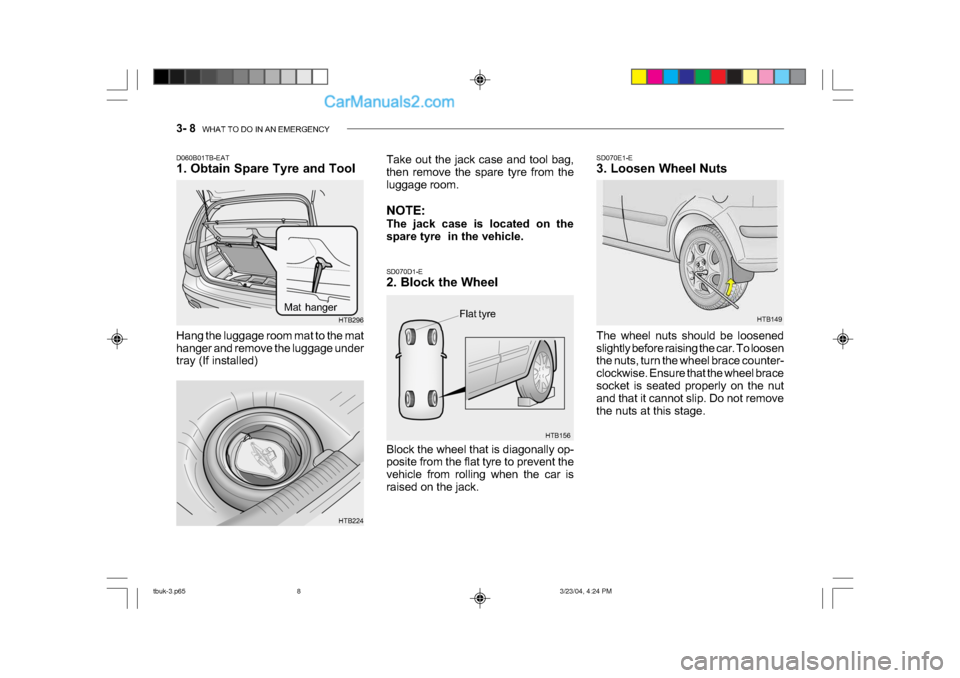
3- 8 WHAT TO DO IN AN EMERGENCY
HTB149
SD070E1-E
3. Loosen Wheel Nuts
The wheel nuts should be loosened
slightly before raising the car. To loosen
the nuts, turn the wheel brace counter-
clockwise. Ensure that the wheel brace
socket is seated properly on the nut
and that it cannot slip. Do not remove
the nuts at this stage.Flat tyre
HTB156
SD070D1-E
2. Block the Wheel
Block the wheel that is diagonally op-
posite from the flat tyre to prevent the
vehicle from rolling when the car is
raised on the jack.
Take out the jack case and tool bag,
then remove the spare tyre from the
luggage room.
NOTE:
The jack case is located on the
spare tyre in the vehicle.
Hang the luggage room mat to the mat
hanger and remove the luggage under
tray (If installed)
D060B01TB-EAT
1. Obtain Spare Tyre and Tool
HTB224
HTB296
Mat hanger
tbuk-3.p65
3/23/04, 4:24 PM
8
Page 372 of 445
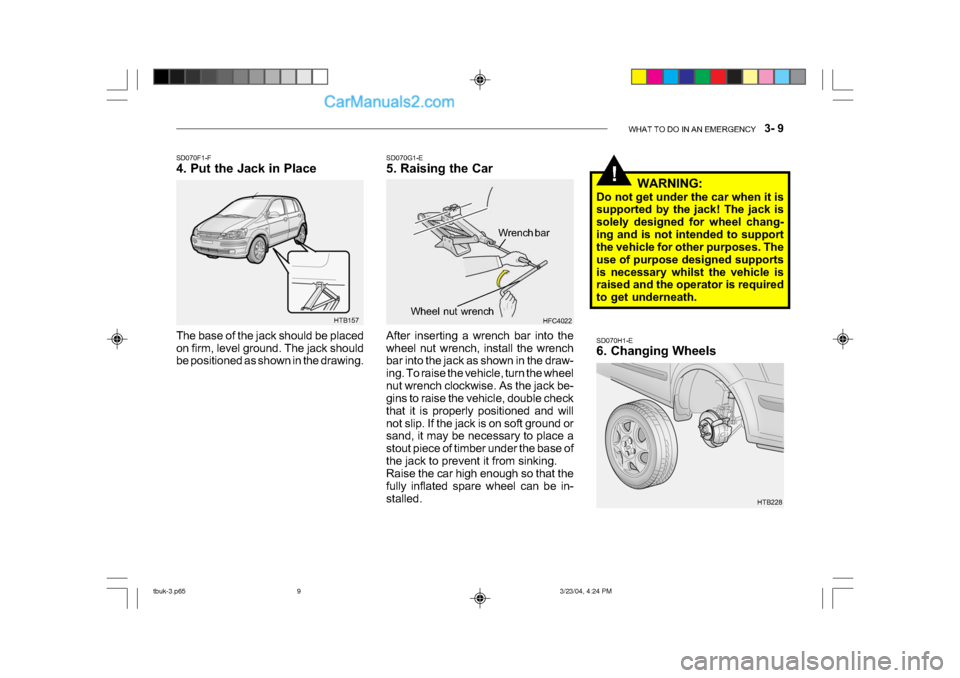
WHAT TO DO IN AN EMERGENCY 3- 9
!
SD070H1-E
6. Changing Wheels
HTB157
SD070F1-F
4. Put the Jack in Place
The base of the jack should be placed
on firm, level ground. The jack should
be positioned as shown in the drawing.
SD070G1-E
5. Raising the Car
After inserting a wrench bar into the
wheel nut wrench, install the wrench
bar into the jack as shown in the draw-
ing. To raise the vehicle, turn the wheel
nut wrench clockwise. As the jack be-
gins to raise the vehicle, double check
that it is properly positioned and will
not slip. If the jack is on soft ground or
sand, it may be necessary to place a
stout piece of timber under the base of
the jack to prevent it from sinking.
Raise the car high enough so that the
fully inflated spare wheel can be in-
stalled. HFC4022
Wrench bar
Wheel nut wrench
WARNING:
Do not get under the car when it is
supported by the jack! The jack is
solely designed for wheel chang-
ing and is not intended to support
the vehicle for other purposes. The
use of purpose designed supports
is necessary whilst the vehicle is
raised and the operator is required
to get underneath.
HTB228
tbuk-3.p65 3/23/04, 4:24 PM
9
Page 373 of 445
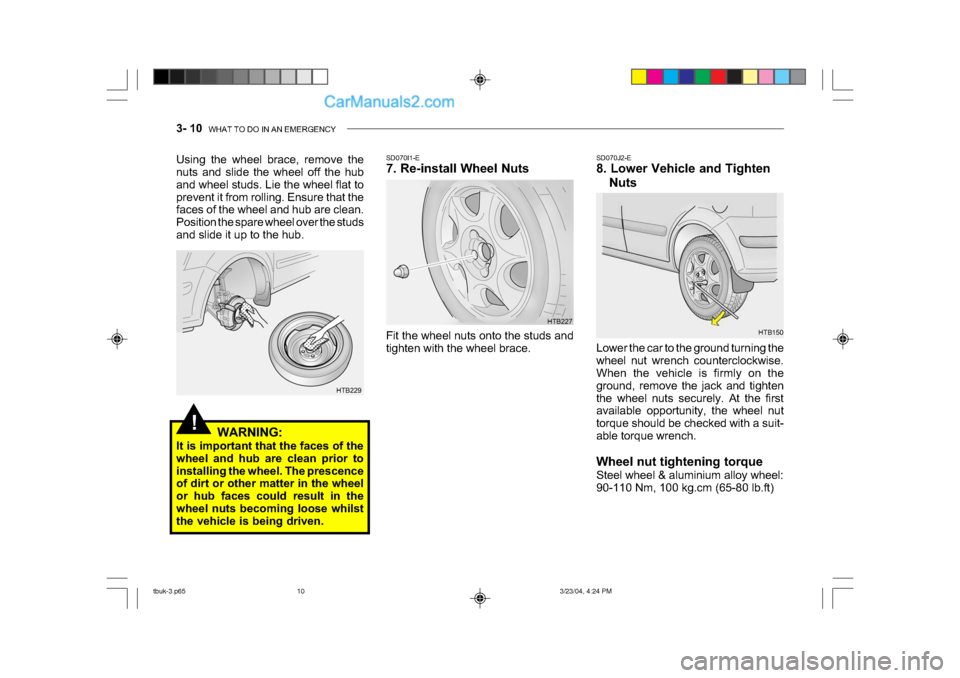
3- 10 WHAT TO DO IN AN EMERGENCY
!
HTB150
SD070J2-E
8. Lower Vehicle and Tighten
Nuts
Lower the car to the ground turning the
wheel nut wrench counterclockwise.
When the vehicle is firmly on the
ground, remove the jack and tighten
the wheel nuts securely. At the first
available opportunity, the wheel nut
torque should be checked with a suit-
able torque wrench.
Wheel nut tightening torque
Steel wheel & aluminium alloy wheel:
90-110 Nm, 100 kg.cm (65-80 lb.ft)
SD070I1-E
7. Re-install Wheel NutsFit the wheel nuts onto the studs and
tighten with the wheel brace.
HTB227
Using the wheel brace, remove the
nuts and slide the wheel off the hub
and wheel studs. Lie the wheel flat to
prevent it from rolling. Ensure that the
faces of the wheel and hub are clean.
Position the spare wheel over the studs
and slide it up to the hub.
HTB229
WARNING:
It is important that the faces of the
wheel and hub are clean prior to
installing the wheel. The prescence
of dirt or other matter in the wheel
or hub faces could result in the
wheel nuts becoming loose whilst
the vehicle is being driven.
tbuk-3.p65 3/23/04, 4:24 PM
10
Page 375 of 445
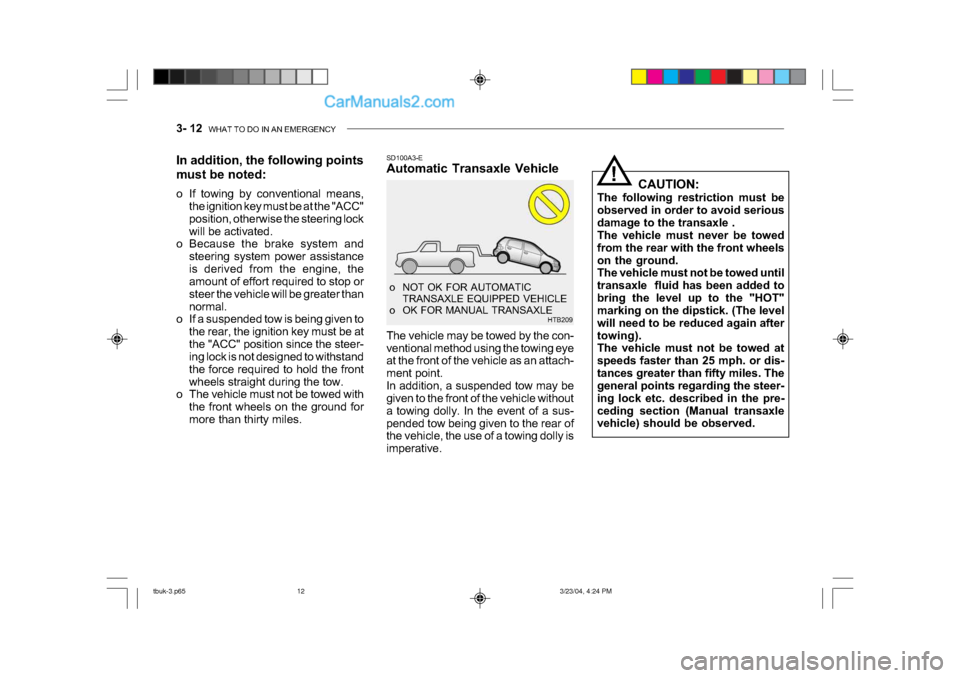
3- 12 WHAT TO DO IN AN EMERGENCY
!
CAUTION:
The following restriction must be
observed in order to avoid serious
damage to the transaxle .
The vehicle must never be towed
from the rear with the front wheels
on the ground.
The vehicle must not be towed until
transaxle fluid has been added to
bring the level up to the "HOT"
marking on the dipstick. (The level
will need to be reduced again after
towing).
The vehicle must not be towed at
speeds faster than 25 mph. or dis-
tances greater than fifty miles. The
general points regarding the steer-
ing lock etc. described in the pre-
ceding section (Manual transaxle
vehicle) should be observed.
SD100A3-E
Automatic Transaxle Vehicle
The vehicle may be towed by the con-
ventional method using the towing eye
at the front of the vehicle as an attach-
ment point.
In addition, a suspended tow may be
given to the front of the vehicle without
a towing dolly. In the event of a sus-
pended tow being given to the rear of
the vehicle, the use of a towing dolly is
imperative.
o NOT OK FOR AUTOMATIC
TRANSAXLE EQUIPPED VEHICLE
o OK FOR MANUAL TRANSAXLE HTB209
In addition, the following points
must be noted:
o If towing by conventional means,
the ignition key must be at the "ACC"
position, otherwise the steering lock
will be activated.
o Because the brake system and
steering system power assistance
is derived from the engine, the
amount of effort required to stop or
steer the vehicle will be greater than
normal.
o If a suspended tow is being given to
the rear, the ignition key must be at
the "ACC" position since the steer-
ing lock is not designed to withstand
the force required to hold the front
wheels straight during the tow.
o The vehicle must not be towed with
the front wheels on the ground for
more than thirty miles.
tbuk-3.p65 3/23/04, 4:24 PM
12
Page 376 of 445
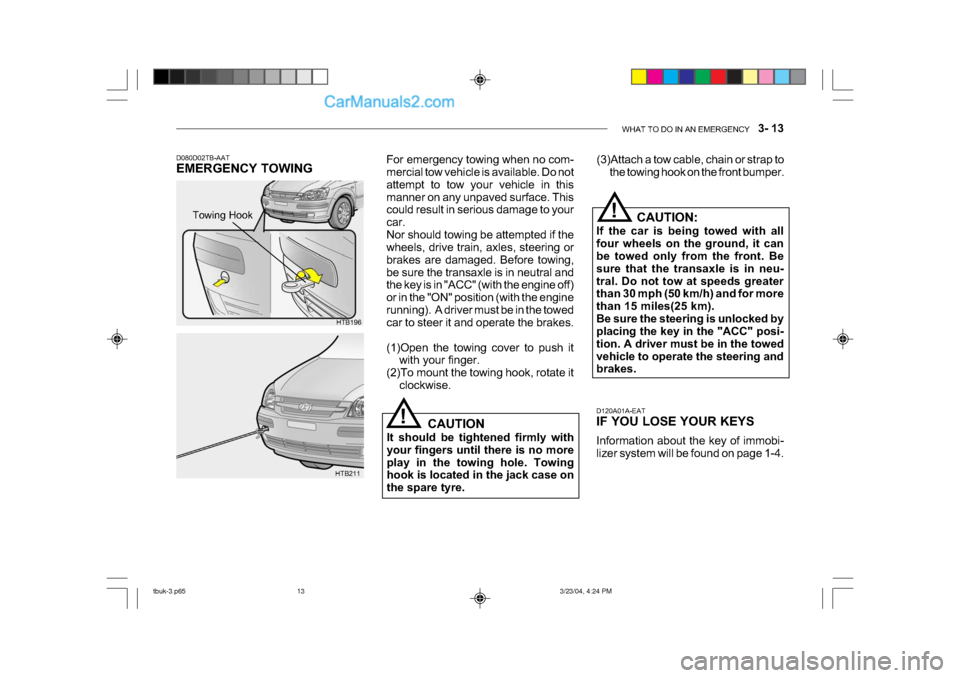
WHAT TO DO IN AN EMERGENCY 3- 13
D120A01A-EAT
IF YOU LOSE YOUR KEYS
Information about the key of immobi-
lizer system will be found on page 1-4.CAUTION:
If the car is being towed with all
four wheels on the ground, it can
be towed only from the front. Be
sure that the transaxle is in neu-
tral. Do not tow at speeds greater
than 30 mph (50 km/h) and for more
than 15 miles(25 km).
Be sure the steering is unlocked by
placing the key in the "ACC" posi-
tion. A driver must be in the towed
vehicle to operate the steering and
brakes.
!
(3)Attach a tow cable, chain or strap to
the towing hook on the front bumper.
D080D02TB-AAT
EMERGENCY TOWING For emergency towing when no com-
mercial tow vehicle is available. Do not
attempt to tow your vehicle in this
manner on any unpaved surface. This
could result in serious damage to your
car.
Nor should towing be attempted if the
wheels, drive train, axles, steering or
brakes are damaged. Before towing,
be sure the transaxle is in neutral and
the key is in "ACC" (with the engine off)
or in the "ON" position (with the engine
running). A driver must be in the towed
car to steer it and operate the brakes.
(1)Open the towing cover to push it
with your finger.
(2)To mount the towing hook, rotate it clockwise.
HTB196
HTB211 CAUTION
It should be tightened firmly with
your fingers until there is no more
play in the towing hole. Towing
hook is located in the jack case on
the spare tyre.
!
Towing Hook
tbuk-3.p65
3/23/04, 4:24 PM
13
Page 386 of 445

VEHICLE MAINTENANCE REQUIREMENTS 5- 5
F030C02TB-EAT R : Replace I : Inspect and, after inspection, clean, adjust, repair or replace if necessary
GENERAL MAINTENANCE COOLING SYSTEMCOOLANTCOOLANT SPECIFIC GRAVITYMANUAL TRANSAXLE OILAUTOMATIC TRANSAXLE FLUIDBRAKE PIPES, HOSES, AND CONNECTIONSBRAKE FLUIDCLUTCH FLUIDREAR BRAKE LININGS AND CYLINDERSBRAKE PADSSUSPENSION AND STEERING SYSTEMFRONT SUSPENSION BALL JOINTSPOLLEN FILTER (FOR EVAPORATOR AND BLOWER UNIT)REAR WHEEL BEARINGSTYRE CONDITION AND PRESSURE (incl. Spare)LUBRICATE LOCKS AND HINGESCHECK ALL ELECTRICAL SYSTEMSROAD TESTCHECK ALL SYSTEMS WITH HI-SCAN
60 72
5060
4048
I I I
R
I
RR II I I
R III I II
I I I IIIII I II
R II I III
I I I II
RR I I II
R II I III
30 36
2024
I I I IIIII I II
R II I III
I I I II
RR I I II
R II I III
10 12
I I I IIIII I II
R II I III
MILES X 1000MONTHS
NO. DESCRIPTION
1 23456789
10111213141516171819
See NOTE (1)
Note :(1) FOR THE FIRST TIME, REPLACE THE COOLANT 60,000 MILES OR 60 MONTHS. AFTER THAT, REPLACE IT EVERY 30,000 MILES OR 24 MONTHS.
tbuk-5.p65 7/3/2008, 4:10 PM
5
Page 399 of 445

6- 8 DO-IT-YOURSELF MAINTENANCE
Petrol engine
HTB169
HTB169A
Diesel engine
G030D01TB-EAT
ENGINE OIL REPLENISHMENT
If the indicated oil level is at or below the
lower mark of the dipstick, oil should be
added until the level is at or below the
upper mark.
To add oil to the engine, remove the
filler cap by rotating in an counterclock-
wise direction and pour engine oil into
the engine. Before checking the level
again, allow several minutes for the oil
to drain into the sump. Replace the oil
filler cap rotating it in a clockwise direc-
tion until tight.
The quantity of oil required to raise the
level from the minimum to maximum
level is approximately 1.2 litre.ZG030E1-E
ENGINE OIL CONSUMPTION
Function of engine oil
Engine oil has the primary function of
lubricating and cooling the inside of the
engine.
Engine oil consumption
It is normal that an engine should con-
sume some engine oil while normal
driving. The cause of oil consumption in
a normal engine are as follows;
o Engine oil is used to lubricate pis-
tons, piston rings and cylinders.
A thin film of oil is left on the cylinder
wall when a piston moves down-
wards in the cylinder. High negative
pressure generated during engine
operation sucks some of the oil into
the combustion chamber.
This oil with some oil of the cylinder
wall is burned by the high tempera-
ture combustion gases during the
combustion process.
o The engine oil consumption is strongly
effected by the viscosity and quality
of oil, engine rpm and driving condi-
tion etc.
tbuk-6.p65 3/23/04, 4:26 PM
8
Page 401 of 445

6- 10 DO-IT-YOURSELF MAINTENANCE
!
!
HTB170
Petrol engine SG050A1-E
ENGINE COOLANT CHECKING
AND REPLACING
SG050B1-E
Coolant recommendations WARNING:
Do not remove the radiator cap when
the engine is hot, since the system is
pressurized and coolant may be
ejected from the radiator resulting in
scalding.
3. Prepare a suitable receptacle to col-
lect the displaced oil and remove the
drain plug from the sump.
4. When the oil has drained from the sump, replace the drain plug using a
new washer ensuring that the plug is
not over tightened.
Tightening torque is: 3.5 ~ 4.5 kgf.m
5. Remove the oil filter by rotating coun- terclockwise, using a proprietary oil
filter removal tool if necessary. Note
that the oil filter will contain approxi-
mately 0.5 litres of oil and this should
be collected in a suitable receptacle.
6. Install a new oil filter having smeared the sealing ring with clean oil and
rotating clockwise until the filter con-
tacts the mounting and then a further
one half turn. Do not over-tighten CAUTION:
The oil being drained from the en-
gine will be hot. Care should be
exercised to prevent scalding.
! Tightening torque:
Petrol -
1.2 ~ 1.6 kgf.m
Diesel(RHD) - 2.3 ~ 2.5 kgf.m
7. Pour the specified quantity of the recommended oil into the engine and
replace the filler cap. Start the en-
gine and ensure that no oil leaks
exist. Turn off the engine and after a
couple minutes, recheck the oil level.
WARNING:
Prolonged and repeated contact with
used engine oils may result in seri-
ous skin disorders including derma-
titis and cancer. Avoid contact with
skin as far as possible and always
wash thoroughly after any contact.
Keep used oils out of reach of chil-
dren. It is illegal to pollute drains,
water courses and soil. Use only
authorized waste collection facili-
ties including civic amenity sites
and garages for the disposal of used
oil and oil filters. If in doubt, contact
the local authority for disposal in-
structions.
tbuk-6.p65 3/23/04, 4:26 PM
10